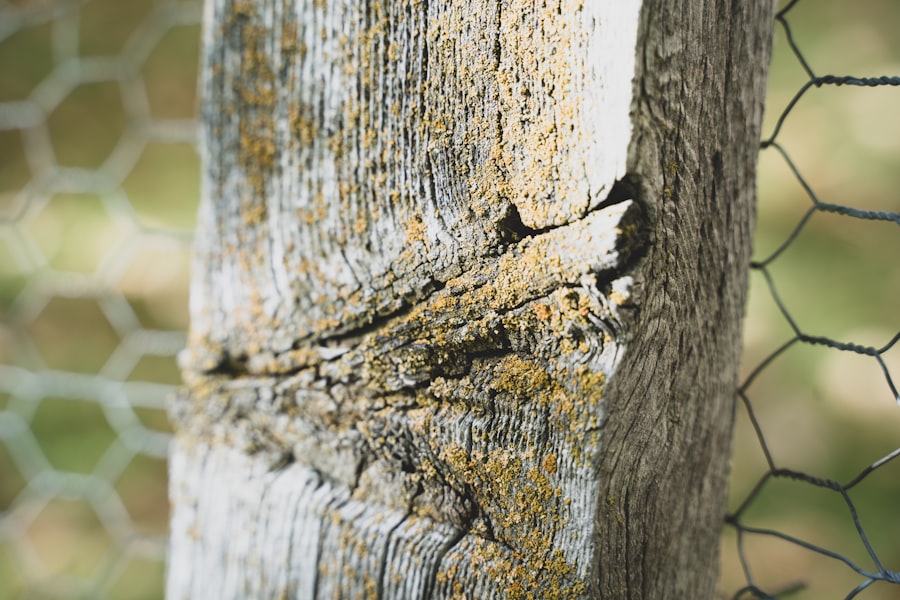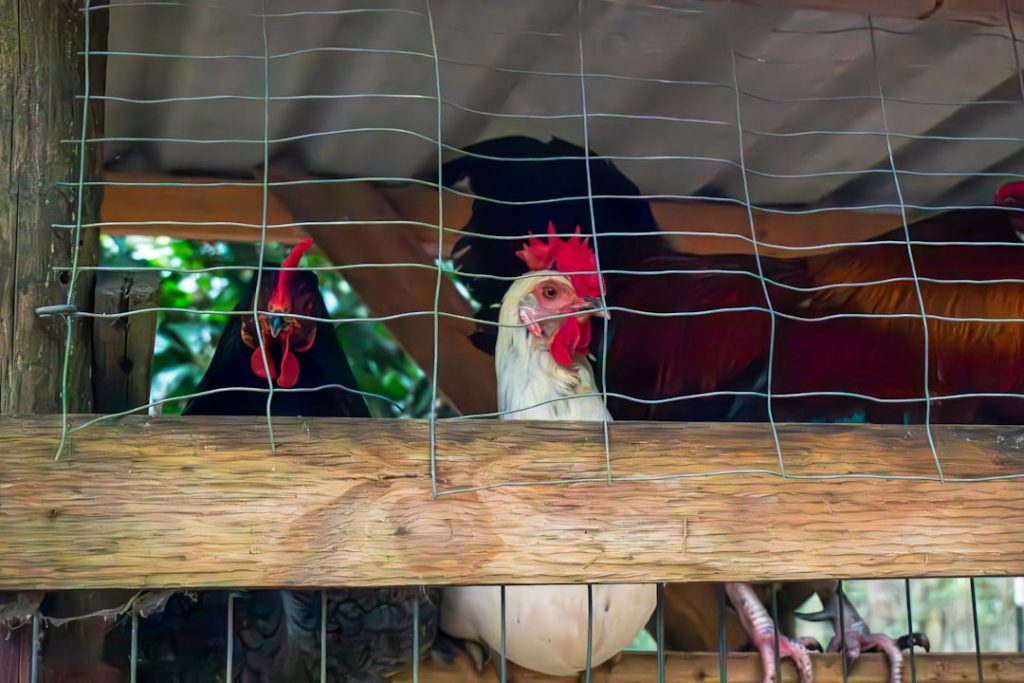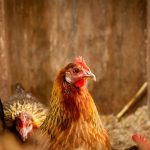Chickens are social creatures that require adequate space for movement, scratching, and pecking. They need protection from predators and other potential threats. When designing a chicken enclosure, it’s essential to consider the chickens’ natural behaviors and requirements.
These include sufficient area for free movement, dust bathing, and foraging. Protection from predators such as foxes, raccoons, and raptors is crucial. Chickens are naturally inquisitive and may attempt to escape if they feel restricted or see something enticing beyond their enclosure.
Understanding these factors is vital when selecting appropriate fencing for a chicken coop. Chickens require a secure environment for egg-laying and nighttime roosting. The fencing should be tall enough to prevent predators from reaching the chickens and sturdy enough to prevent escapes.
Different chicken breeds have varying tendencies to fly or jump, which should be taken into account when choosing fence height and type. By comprehending chickens’ needs, one can make well-informed decisions about the most suitable fencing for their flock.
Table of Contents
- 1 Choosing the Right Fence Height
- 2 Factors to Consider When Determining Fence Height
- 3 Types of Fencing for Chicken Enclosures
- 4 Additional Considerations for Chicken Enclosures
- 5 Maintenance and Upkeep of Chicken Fencing
- 6 Ensuring the Safety and Security of Your Chickens
- 7 FAQs
- 7.1 What height should a fence be to keep chickens in?
- 7.2 Why is a 6-foot fence recommended for keeping chickens in?
- 7.3 Are there any other factors to consider when choosing a fence for chickens?
- 7.4 Can certain chicken breeds fly over a 6-foot fence?
- 7.5 Are there any alternatives to a tall fence for keeping chickens in?
Key Takeaways
- Chickens have specific needs for space, protection, and safety, which should be considered when designing their enclosure.
- The right fence height for chicken enclosures depends on factors such as the size and breed of the chickens, as well as the predators in the area.
- When determining fence height for chicken enclosures, factors such as predator threats, chicken behavior, and the terrain should be taken into account.
- There are various types of fencing options for chicken enclosures, including wire mesh, electric fencing, and hardware cloth, each with its own advantages and disadvantages.
- Additional considerations for chicken enclosures include predator-proofing the coop, providing adequate shelter, and ensuring proper ventilation and drainage.
Choosing the Right Fence Height
Fence Height and Chicken Breed
The height of the fence will depend on the size and breed of the chickens. In general, a good rule of thumb is to have a fence that is at least 6 feet tall to provide adequate protection for most chicken breeds.
Considering Predators and Flight Risks
However, if you have larger or more active breeds, or if you live in an area with a high population of predators, you may want to consider a taller fence. Another factor to consider is the potential for chickens to fly or jump over the fence. Some chicken breeds are more prone to flying or jumping than others, so it’s important to take this into account when determining the appropriate height for the fence.
Special Considerations for Young Chicks and Bantam Breeds
Additionally, if you have young chicks or bantam breeds, you may need to consider a lower fence height to prevent them from escaping. Ultimately, the right fence height will provide adequate protection for your chickens while also allowing them to move around freely and engage in natural behaviors.
Factors to Consider When Determining Fence Height

When determining the appropriate fence height for a chicken enclosure, there are several important factors to consider. One of the most important factors is the size and breed of the chickens. Larger breeds may require a taller fence to prevent them from flying or jumping over it, while smaller breeds may be content with a lower fence height.
Additionally, some chicken breeds are more prone to escaping than others, so it’s important to take this into account when determining the appropriate fence height. Another factor to consider is the potential threats in the area. If you live in an area with a high population of predators such as foxes, raccoons, or birds of prey, you may need a taller fence to provide adequate protection for your chickens.
It’s also important to consider any potential entry points for predators, such as trees or structures that could allow them to access the enclosure from above. By taking these factors into consideration, you can determine the appropriate fence height that will provide the necessary protection for your flock.
Types of Fencing for Chicken Enclosures
There are several types of fencing that can be used for chicken enclosures, each with its own advantages and disadvantages. One common option is poultry netting, which is a lightweight and flexible option that can be easily installed and moved as needed. Poultry netting is effective at keeping chickens contained and can also provide some protection from predators, although it may not be as durable as other options.
Another popular choice for chicken enclosures is hardware cloth, which is a sturdy wire mesh that provides excellent protection from predators. Hardware cloth is durable and long-lasting, making it an ideal choice for areas with high predator populations. However, it can be more expensive and labor-intensive to install than other options.
Chain link fencing is another option for chicken enclosures, providing a strong and durable barrier that can effectively keep predators out. Chain link fencing is also relatively low-maintenance and long-lasting, making it a popular choice for many chicken owners. However, it can be more expensive than other options and may not provide as much protection from aerial predators.
Wood fencing is another option for chicken enclosures, providing a solid barrier that can effectively keep chickens contained and protected from predators. Wood fencing can also provide privacy and shelter for the chickens, although it may require more maintenance than other options.
Additional Considerations for Chicken Enclosures
In addition to choosing the right type and height of fencing for a chicken enclosure, there are several additional considerations to keep in mind. One important consideration is the need for a secure coop within the enclosure where the chickens can roost at night and lay their eggs. The coop should be predator-proof and provide adequate ventilation and space for the chickens.
Another consideration is the need for a secure door or gate that can be locked at night to prevent predators from accessing the enclosure. The door or gate should be sturdy and well-constructed to prevent break-ins by predators. It’s also important to consider the overall layout and design of the chicken enclosure, including any additional features such as perches, dust bathing areas, and shelters.
Providing these features can help create a more natural and enriching environment for the chickens while also promoting their health and well-being. Finally, it’s important to regularly inspect and maintain the fencing and enclosure to ensure that it remains secure and effective at protecting the chickens from potential threats. This may include repairing any damage to the fencing, reinforcing weak spots, and removing any potential entry points for predators.
Maintenance and Upkeep of Chicken Fencing

Regular Inspections are Key
Once you have chosen and installed the appropriate fencing for your chicken enclosure, it’s essential to regularly maintain and upkeep the fencing to ensure its effectiveness at protecting your flock. Regular maintenance can help prevent damage to the fencing and identify any potential weak spots that could allow predators to access the enclosure. One crucial aspect of maintenance is regularly inspecting the fencing for any signs of wear or damage.
Identifying and Repairing Damage
This may include checking for holes or tears in poultry netting, loose or rusted wires in hardware cloth, or damaged sections of chain link or wood fencing. Any damage should be promptly repaired to prevent predators from accessing the enclosure. It’s also important to regularly trim back any vegetation that could potentially compromise the security of the fencing. Overgrown bushes or trees near the enclosure could provide a potential entry point for predators, so it’s essential to keep these areas clear.
Securing the Entrance and Monitoring the Enclosure
Regularly inspecting and maintaining the door or gate to the enclosure is also crucial for preventing break-ins by predators. The door or gate should be securely locked at night and regularly checked for any signs of damage or wear. Finally, it’s essential to regularly monitor the overall security of the enclosure and make any necessary adjustments or improvements as needed. This may include adding additional reinforcement to weak spots in the fencing or making changes to the layout of the enclosure to better protect your flock.
Ensuring the Safety and Security of Your Chickens
In conclusion, choosing the right fencing for a chicken enclosure is crucial for ensuring the safety and security of your flock. By understanding the needs of chickens and considering factors such as breed size, potential threats, and flying abilities, you can determine the appropriate type and height of fencing for your specific situation. Additionally, regular maintenance and upkeep of the fencing is essential for preventing damage and maintaining its effectiveness at protecting your chickens from predators.
By providing a secure and enriching environment for your chickens, you can help promote their health and well-being while also giving yourself peace of mind knowing that they are safe from potential threats. Whether you choose poultry netting, hardware cloth, chain link, or wood fencing, taking the time to carefully consider your options and regularly maintain your enclosure will help ensure that your chickens are safe and secure in their home.
If you’re considering building a fence to keep your chickens in, you may also be interested in learning about the best chicken feed for your flock. Check out this article on poultrywizard.com to find out if geese can eat chicken feed and how to best provide for your feathered friends.
FAQs
What height should a fence be to keep chickens in?
The recommended height for a fence to keep chickens in is at least 6 feet tall. This height will prevent most chicken breeds from flying or jumping over the fence.
Why is a 6-foot fence recommended for keeping chickens in?
A 6-foot fence is recommended to prevent most chicken breeds from flying or jumping over the fence. It provides a sufficient barrier to keep the chickens contained within the designated area.
Are there any other factors to consider when choosing a fence for chickens?
In addition to height, it’s important to consider the material and durability of the fence. Chicken wire or hardware cloth are commonly used for chicken fences, as they are effective at containing the birds and protecting them from predators.
Can certain chicken breeds fly over a 6-foot fence?
Some chicken breeds, such as certain bantam breeds, may still be able to fly over a 6-foot fence. In such cases, additional measures such as clipping their wings or using netting over the fenced area may be necessary to keep them contained.
Are there any alternatives to a tall fence for keeping chickens in?
In addition to a tall fence, other alternatives for keeping chickens in include using electric fencing, creating a covered run, or using poultry netting to enclose the area. These options can provide effective containment for chickens while offering different levels of protection and flexibility.
Meet Walter, the feathered-friend fanatic of Florida! Nestled in the sunshine state, Walter struts through life with his feathered companions, clucking his way to happiness. With a coop that’s fancier than a five-star hotel, he’s the Don Juan of the chicken world. When he’s not teaching his hens to do the cha-cha, you’ll find him in a heated debate with his prized rooster, Sir Clucks-a-Lot. Walter’s poultry passion is no yolk; he’s the sunny-side-up guy you never knew you needed in your flock of friends!







